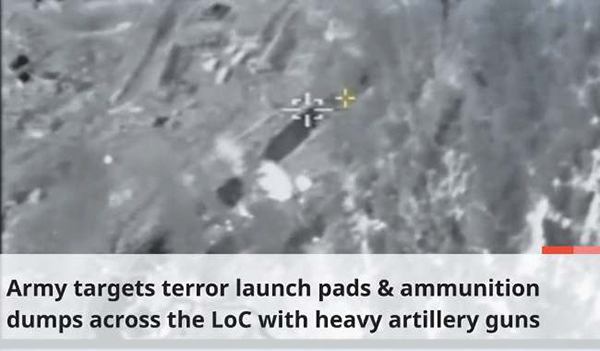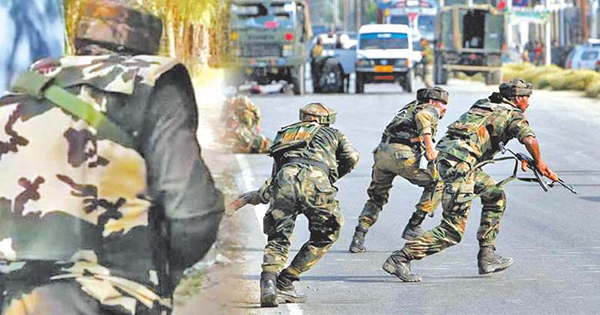During April 2020, a number of terror launch pads along the Pakistani side of the Line of Control (LoC) were destroyed by the Indian Army. India has been retaliating strongly to the Pakistani “misadventure” by targeting terror launch pads and ammunition storage across the LoC.
Handwara Operation
In the Army’s best traditions, Colonel Ashutosh Sharma, a decorated commanding officer of a Rashtriya Rifles battalion, along with company commander Maj Anuj Sood, two other soldiers and a policeman laid down their lives in a fierce encounter with terrorists at Chanjimulla area of Handwara in north Kashmir’s Kupwara district on 2 May.
Two terrorists were killed in the encounter, one of whom was identified as top Lashkar-e-Taiba (LeT) commander Haidar alias Iqbal, a resident of Pakistan-occupied Kashmir. They were part of a large group of Pakistani infiltrators who had sneaked into Kashmir through the Wadarbala-Rajwara forests in Kupwara in April. Col Sharma and his team reached the site after receiving reports that civilians were being held hostage in a house by terrorists. The Army officers were leading a team to rescue civilians who had been taken hostage by the terrorists.
Kishtwar Encounter
In a gunfight in Kishtwar district, on 17 April, two militants were slain. They had killed a Special Police Officer and injured another near Dacchan a week earlier, before decamping with their weapons. The weapons were recovered after the encounter near Sounder village.
In another encounter at Dairoo village in South Kashmir’s Shopian the same day two militans killed.
Keran Gunfight
The Army suffered its biggest casualties in a day since the abrogation of Article 370 in Jammau & Kashmir (J&K), on 5 April. It was foiling an infiltration bid at a high-altitude pass on the Line of Control (LoC) at Shalbatoo, in the Jumgund area of the Keran sector in Kupwara in north Kashmir, in tough terrain and bad weather.
Five members of the elite para unit – 4 Para – and five militants were killed in the fierce hand-to-hand combat and gunfight in the snowbound Ringdori forest area of Keran, 120 km from Srinagar. The unit took part in the 2016 cross-LoC surgical strikes in the Pakistan Occupied Kashmir (PoK).

The special forces troopers, who had been air dropped near the LoC after information on the infiltrators was received, were found just six feet away from the terrorists, who they eliminated in an intense battle when the search party found them . They had infiltrated across the LoC from Qasim-II post in PoK and were headed to the Gulab Post on the Indian side.
At least three of the five terrorists gunned down on April 5 in the Keran sector belonged to Jammu & Kashmir and had gone across the border to Pakistan for training in 2018. Five AK-47 rifles, grenades, and GPS and wireless sets were recovered from the encounter site.
Kulgam Gunfight
A day earlier, on 4 April, four terrorists of Hizbul Mujahideen (HuM) responsible for killing several civilians were shot dead by security forces in a shootout in Kulgam district of Jammu & Kashmir. Two soldiers of the Indian Army were also injured in the encounter, which took place in Hardmand Guri village of Kulgam. The house in which the terrorists were held up was demolished.
Army’s Response
The army responded to the unprovoked ceasefire violation and the killing of Special Forces commandos, on 10 April, by targeting Pakistani positions across the LoC in the Keran sector with artillery guns and caused severe damage to posts, terror launch pads and an ammunition dump in PoK.
A 48-second video clip released showed heavy and precision artillery blasting some positions, including an ammunition dump that was seen exploding in a huge ball of fire. It was a message to Pakistan that nothing goes unpunished.
The assault on terror launch pads at Dudhnial facing the Keran sector killed eight terrorists and 15 Pakistan Army soldiers. There was an effort to camouflage the extent of the casualties on the Pakistani side.
It was from Dudhnial that the five terrorists neutralised by the Indian Army special forces in the Keran sector on April 5 had been launched.
The Indian Army had no option since credible information suggested that nearly 160 terrorists of mixed tanzeems – LeT, Jaish e Mohammed and HuM – were waiting in the area to infiltrate into Kashmir.
At least one terror launch pad, among other targets, was apparently “completely destroyed” in the firing by the Indian Army, which used 105mm field guns as well as 155mm Bofors howitzers.
Defence minister Rajnath Singh, on 19 April, said the Indian Army was carrying out “targeted strikes” on terror launch pads along the LoC in Jammu & Kashmir and eliminating the Pakistani infiltrators before they crossed over to the Indian side.
“As you would have gathered from the operations along the LoC in the last two weeks, we are dominating the enemy through targeted intelligence based strikes on their launch pads and eliminating them before they set foot on Indian soil,” Singh said.
Comments
Dispite the coronavirus (Covid-19) panedemic spreading in Pakistan, there has been a spike in incidents across the LoC suggested that the operations to foment trouble in Kashmir – by first radicalising locals in Valley; then getting them to cross over for weapons training with terror groups such as the LeT, Jaish-e-Mohammed and HM; and then sending them back to wage war in India. There were attempts to smuggle assault rifles across LoC to supply to foreign and local terrorists in the Valley. Other moves which include propping up smaller indigenous armed groups, were linked with retaliation against India for the August 2019 nullification of Article 370.
Pakistan often resorts to ceasefire violations to push militants into the Indian side. Indian troops have also been retaliating to Pakistani actions under its policy of hot pursuit.


















